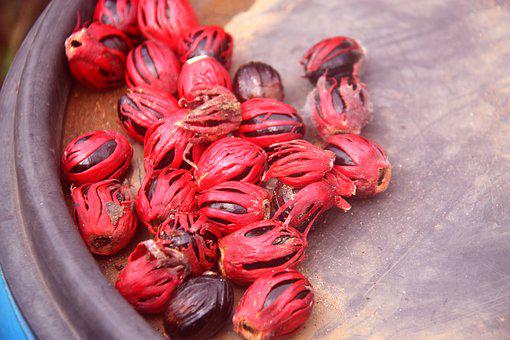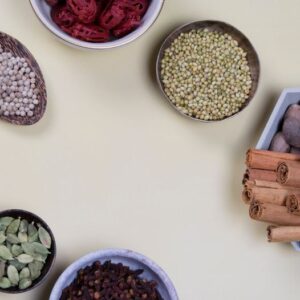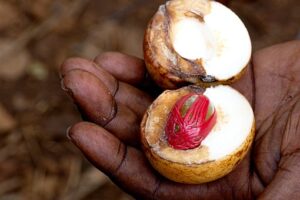We are familiar with using nutmeg in eggnog and other fall treats, frequently in combination with cinnamon. But the composition and background of this warming spice are also highly fascinating. People around the world originally praised nutmeg as being “worth its weight in gold.” Two wildly diverse spices from one tree. Yes, the nutmeg tree, an enormous evergreen that yields both nutmeg and mace, exists.
In contrast to mace, which is the lacy coating (aril) on the kernel, nutmeg is the seed kernel located inside the fruit. The biggest of Indonesia’s Molucca spice islands, Banda, is where the nutmeg tree that bears its name originated. Nutmeg as a popular spice is widely available with other Indian spices online.
Origin of Nutmeg and Nutmeg Mace-
The nutmeg tree, also known by its botanical name Myristica fragrans, is indigenous to Banda, the biggest of Indonesia’s Molucca spice islands. In the first century CE, the Roman historian Pliny wrote about a tree that produced two nuts with different flavours, which is when this spice’s history begins.
To maintain control over nutmeg production in the East Indies, the Dutch engaged in a brutal conflict that resulted in the murder and slavery of the Banda island’s residents. Later, during discussions for the Island of Manhattan, the Dutch exchanged the sovereignty of Manhattan for possession of a British-owned island that produced nutmeg.
Now, with the authenticity and automatic flavour, many Indian buy nutmeg and nutmeg mace from the Indian spices website.
Cultivation of Nutmeg and Nutmeg Mace-
Since nutmeg and mace can be utilized as different spices, their cultivation, development, and harvest are identical. Generally, seeds are used to grow nutmeg trees. In a tray, the seeds are first grown into saplings. The seedlings are then moved to pits as they begin to develop. The nutmeg tree is evergreen and has tiny, light yellow bell-shaped blooms that have a unique scent while in bloom. Its oblong, egg-shaped leaves also have this form. The fruit is bright yellow with red and green patterns that resemble giant plums or apricots. The fruit’s outer fleshy layer is typically candied or pickled as a snack in Malaysia explodes to reveal the seed as it ripens.
The mace section of the nutmeg, known as an aril, is the crimson membrane that encases the seed. After the seed has been dried for up to two months the interior nut is then allowed to rattle inside the shell. The Edie nutmeg in the shape of an egg is then exposed when the shell stands removed. Monsoon is the most suitable time to plant it. They require some shade and appropriate irrigation throughout the summer, especially when they are young. Fast-growing shade plants like Erythrina, bananas, and other species are often cultivated a few months before the nutmeg planting season.
In 7 to 8 years, trees that are grown from seedlings begin to produce. After 15 to 20 years, they reach their full pertinence stage. The life expectancy of nutmeg trees is astoundingly long—nearly 60 years! These trees are beautiful because they bloom all year round. The nutmeg tree has a minimum height of 66 feet. The “nutmeg apple” is the name of the fruit that it produces, which has a form that is similar to a peach. The fruit is typically thrown away but the seed (nut) is kept. But to save some time and get the original nutmeg you can always opt for the South Indian spices online or online masala stores where you can find a variety of collections.
Value –
You might be asking why a spice we use to garnish a holiday beverage would result in such carnage and unrest. It turns out that nutmeg was a popular hallucinogen among the affluent; the heady spice could make you feel as though you were soaring.
Half a kilogramme of nutmeg is equivalent to three lambs or a cow in price in the fourteenth century. The Dutch deliberately set fire to whole nutmeg warehouses in Amsterdam, keeping the price of the spice artificially high. Nutmeg cost between 85 and 90 shillings per pound in London in 1760.
Uses of Nutmeg and Nutmeg Mace-
- Physicists and perfumeries commonly use spice’s essential oil, made by steam distilling powdered nutmeg.
- It aids with diarrhoea, nausea, stomach cramps, and intestinal gas treatment. Also, it has been used to treat insomnia, rheumatoid arthritis, cancer, and renal illness.
- Also, this oil is utilised to treat aches and pains in the muscles.
- Mace and nutmeg are both used in savoury and sweet foods. This is the only spice that unites the entire world; nutmeg is a crucial ingredient in all of them, including the Indian garam masala, Canadian eggnog, Italian tortellini, American pumpkin pie, Irish mulled cider, and Scottish haggis.
- Due to its stimulant, carminative, astringent, and aphrodisiac characteristics, it is used as a drug in Eastern nations.
Thus, nutmeg is an essential spice that also offers numerous health benefits. Used as a sweet spice in puddings, baked foods, vegetables, and sausages. To make your dishes even more mouth watery, start ordering your nutmeg spice quotient now from https://thottamfarmfresh.com/thottam-shop/






